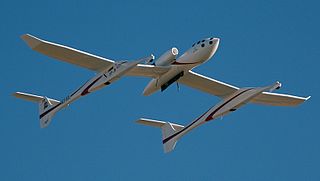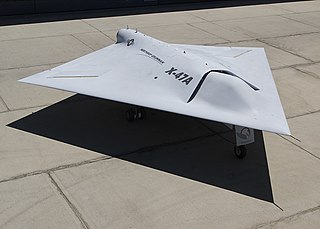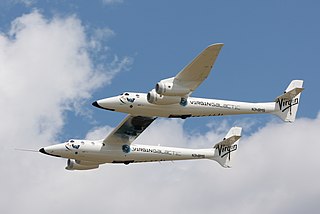
SpaceShipOne is an experimental air-launched rocket-powered aircraft with sub-orbital spaceflight capability at speeds of up to 3,000 ft/s (2,000 mph) / 910 m/s (3,300 km/h) using a hybrid rocket motor. The design features a unique "feathering" atmospheric reentry system where the rear half of the wing and the twin tail booms folds 70 degrees upward along a hinge running the length of the wing; this increases drag while retaining stability. SpaceShipOne completed the first crewed private spaceflight in 2004. That same year, it won the US$10 million Ansari X Prize and was immediately retired from active service. Its mother ship was named "White Knight". Both craft were developed and flown by Mojave Aerospace Ventures, which was a joint venture between Paul Allen and Scaled Composites, Burt Rutan's aviation company. Allen provided the funding of approximately US$25 million.

Elbert Leander "Burt" Rutan is a retired American aerospace engineer and entrepreneur noted for his originality in designing light, strong, unusual-looking, and energy-efficient air and space craft. He designed the record-breaking Voyager, which in 1986 was the first plane to fly around the world without stopping or refueling. He also designed the Virgin Atlantic GlobalFlyer, which in 2006 set the world record for the fastest and longest nonstop non-refueled circumnavigation flight in history. In 2004, Rutan's sub-orbital spaceplane design SpaceShipOne became the first privately funded spacecraft to enter the realm of space, winning the Ansari X-Prize that year for achieving the feat twice within a two-week period.

The Scaled Composites Model 318 White Knight is a jet-powered carrier aircraft that was used to launch its companion SpaceShipOne, an experimental spaceplane. The White Knight and SpaceShipOne were designed by Burt Rutan and manufactured by Scaled Composites, a private company founded by Rutan in 1982. On three separate flights in 2004, White Knight conducted SpaceShipOne into flight, and SpaceShipOne then performed a sub-orbital spaceflight, becoming the first private craft to reach space.

The Northrop Grumman X-47 is a demonstration unmanned combat aerial vehicle. The X-47 began as part of DARPA's J-UCAS program, and is now part of the United States Navy's UCAS-D program to create a carrier-based unmanned aircraft. Unlike the Boeing X-45, initial Pegasus development was company-funded. The original vehicle carries the designation X-47A Pegasus, while the follow-on naval version is designated X-47B.

Michael Winston Melvill is a world-record-breaking pilot and one of the test pilots for SpaceShipOne, the experimental spaceplane developed by Scaled Composites. Melvill piloted SpaceShipOne on its first flight past the edge of space, flight 15P on June 21, 2004, thus becoming the first commercial astronaut, and the 435th person to go into space. He was also the pilot on SpaceShipOne's flight 16P, the first competitive flight in the Ansari X Prize competition.

The Mojave Air and Space Port at Rutan Field is in Mojave, California, United States, at an elevation of 2,801 feet (854 m). It is the first facility to be licensed in the United States for horizontal launches of reusable spacecraft, being certified as a spaceport by the Federal Aviation Administration on June 17, 2004. The facility covers 2,998 acres and has three runways.

Tier One was a Scaled Composites' 1990s–2004 program of suborbital human spaceflight using the reusable spacecraft SpaceShipOne and its launcher White Knight. The craft was designed by Burt Rutan, and the project was funded 20 million US Dollars by Paul Allen. In 2004 it made the first privately funded human spaceflight and won the 10 million US Dollars Ansari X Prize for the first non-governmental reusable crewed spacecraft.

The Rutan VariEze is a composite, canard aircraft designed by Burt Rutan. It is a high-performance homebuilt aircraft, hundreds of which have been constructed. The design later evolved into the Long-EZ and other, larger cabin canard aircraft. The VariEze is notable for popularizing the canard configuration and moldless glass cloth composite construction for homebuilt aircraft.
Mojave Aerospace Ventures (MAV) is a company founded by Paul Allen and Burt Rutan to handle the commercial spinoffs from the Tier One project. It owns the intellectual property arising from Tier One, and it is in turn owned by Allen and Rutan's Scaled Composites. In 2004, it signed a deal with Virgin Galactic to develop the Virgin SpaceShip, a suborbital spacecraft, for space tourism. Virgin Group and Scaled Composites have subsequently formed a joint venture, The Spaceship Company, to manufacture the spacecraft.

The Scaled Composites Model 281 Proteus is a tandem-wing high-altitude long-endurance aircraft designed by Burt Rutan to investigate the use of aircraft as high-altitude telecommunications relays. The Proteus is a multi-mission vehicle able to carry various payloads on a ventral pylon. The Proteus has an extremely efficient design and can orbit a point at over 19,800 m for more than 18 hours. It is currently owned by Northrop Grumman.

The Scaled Composites Model 348 White Knight Two (WK2) is a quadjet cargo aircraft that is used to lift the SpaceShipTwo spacecraft to release altitude. It was developed by Scaled Composites from 2007 to 2010 as the first stage of Tier 1b, a two-stage to suborbital-space crewed launch system. WK2 is based on the successful mothership to SpaceShipOne, White Knight, which itself is based on Proteus.

The Spaceship Company (TSC) is a British/American spacecraft manufacturing company that was founded by Burt Rutan and Richard Branson in mid-2005 and was jointly owned by Virgin Group (70%) and Scaled Composites (30%) until 2012 when Virgin Galactic became the sole owner. TSC was formed to own the technology created by Scaled for Virgin Galactic's Virgin SpaceShip program. This includes developments on the care-free reentry system and cantilevered-hybrid rocket motor, licensed from Paul Allen and Burt Rutan's Mojave Aerospace. The company is manufacturing Virgin Galactic's spacecraft and will sell spacecraft to other buyers. The suborbital launch system offered will include the SpaceShipTwo spacecraft and the White Knight Two carrier aircraft.
SpaceShip III is an upcoming class of spaceplanes by Virgin Galactic to follow SpaceShipTwo. It was first teased on the Virgin Galactic Twitter account on 25 February 2021 announcing the rollout of the first SpaceShip III plane on 30 March 2021.

The Rutan VariViggen is a homebuilt aircraft designed by Burt Rutan. The aircraft is a tandem two-seater of primarily wooden construction with a delta wing and a canard foreplane. The VariViggen is powered by a 150 hp Lycoming O-320 aero engine in pusher configuration. The prototype was designated Model 27, and the production version was Model 32.
The Scaled Composites Model 133-4.62 ATTT, or Advanced Technology Tactical Transport was a technology demonstration project built by Burt Rutan's Scaled Composites in 1986 under contract to DARPA.

The Scaled Composites Triumph is a twin-engine, business jet prototype designed and built by Burt Rutan's Scaled Composites for Beechcraft. It was known officially as the Model 143, and internally at Scaled as the "Tuna". The aircraft is a three lifting surface design, with both a small canard, and a small conventional horizontal stabilizer in a T-tail configuration.

Stargazer is a Lockheed L-1011 TriStar built in 1974, that was modified in 1994 for use by Orbital Sciences as a mother ship launch pad for the Pegasus launch vehicle. As of October 2022, 45 rockets have been launched from it, using the Pegasus-H and Pegasus-XL configurations. As of 2019, Stargazer is the only L-1011 airframe still airworthy.

The Northrop Grumman Firebird is an intelligence gathering aircraft designed by Northrop Grumman's subsidiary Scaled Composites which can be flown remotely or by a pilot. At Scaled, it is known as the Model 355. It was unveiled on May 9, 2011. It was first flown in February 2010 and is considered to be an optionally piloted vehicle (OPV).
Pegasus II, also known as Thunderbolt, was an air-launched orbital rocket under development in 2012–2015 by Orbital Sciences Corporation for use by Stratolaunch Systems.
























